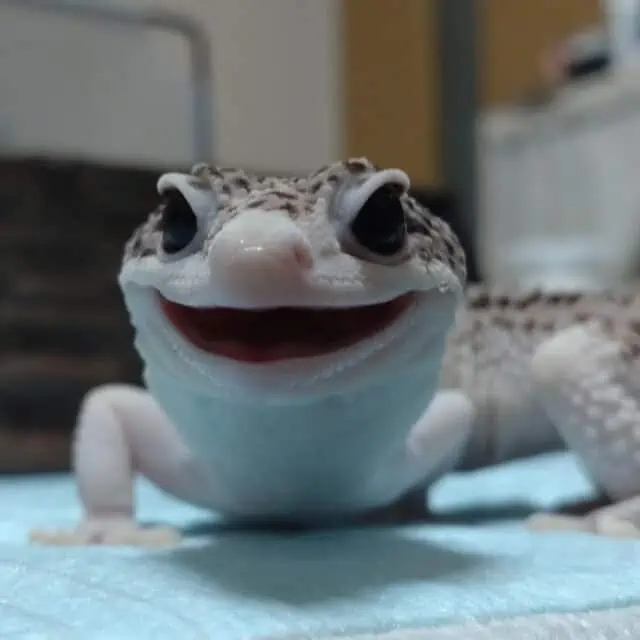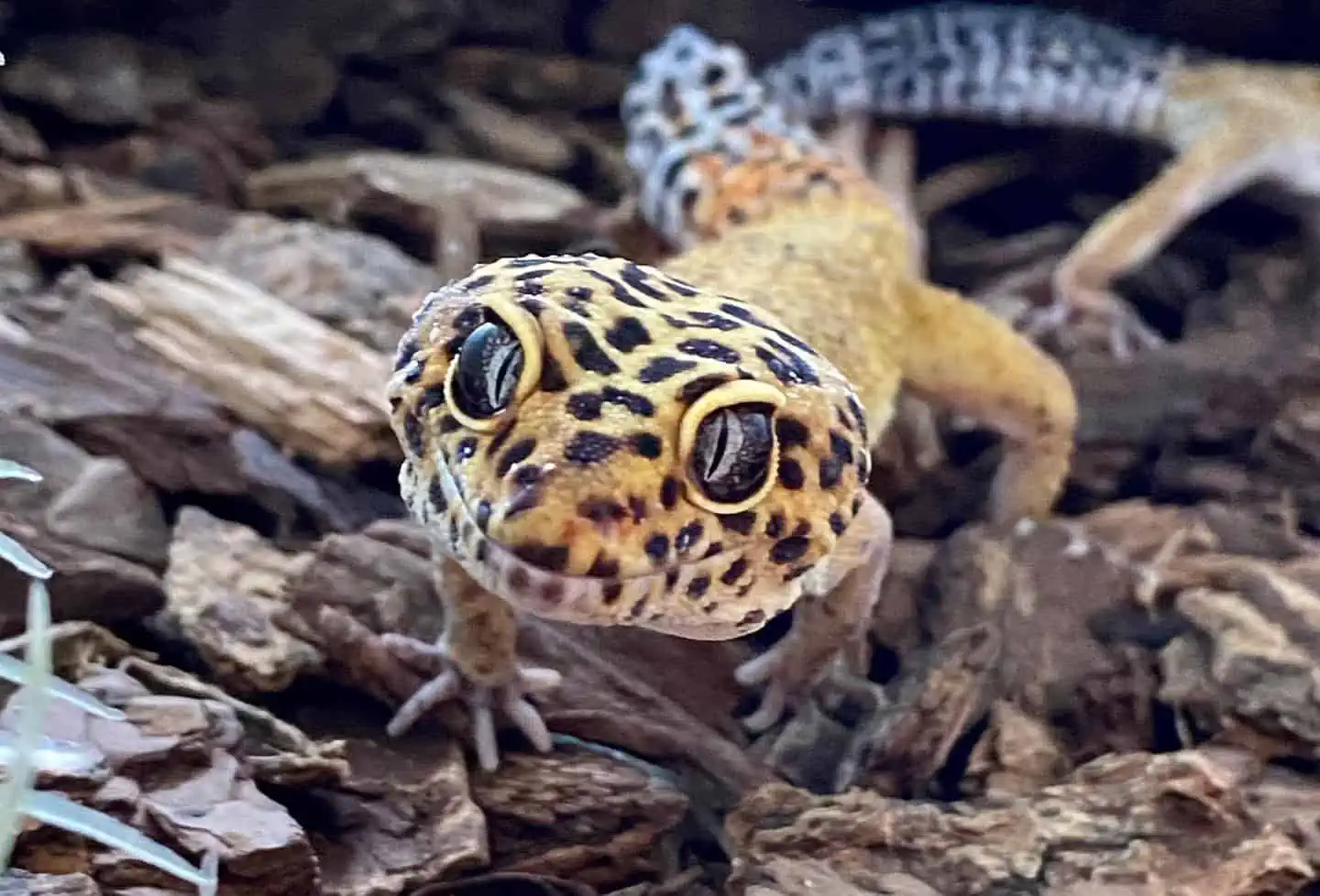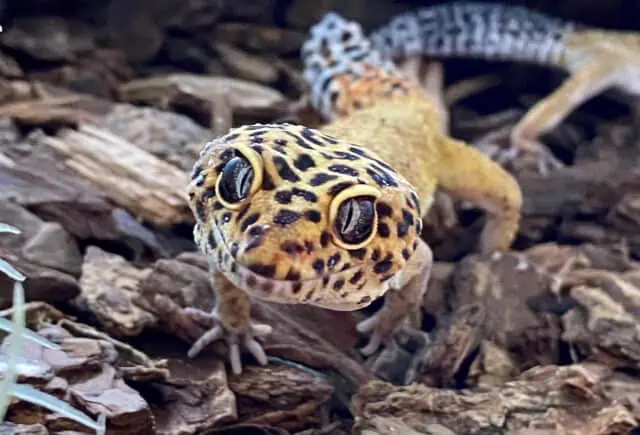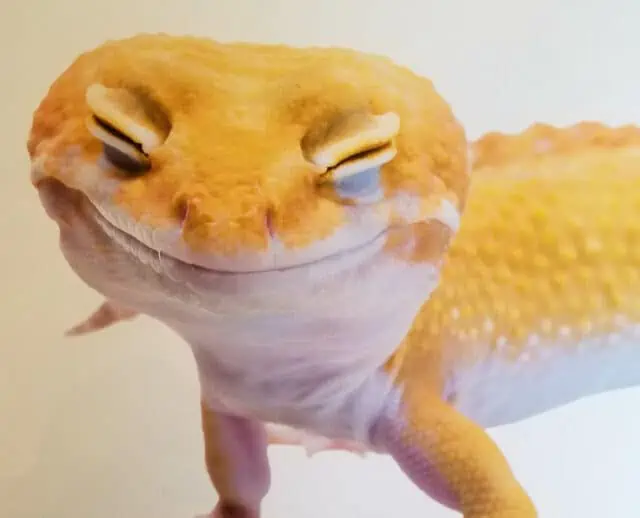Leopard Geckos may give the impression that they’re smiling because of their unique facial structure, which naturally mimics the appearance of a smile. This intriguing look is not an expression of their emotions but a combination of various anatomical features.
The head shape, mouth structure, cheek folds, and half-closed eyes due to movable eyelids all contribute to this illusion. Each of these aspects plays a significant role in giving the leopard gecko its seemingly cheerful demeanor.
Smile Illusion: Leopard geckos appear to smile not due to emotions but due to their anatomical features like head shape, mouth structure, and cheek folds.
Expressing Pleasure: Leopard geckos express contentment through behavioral cues like wagging their tail, displaying a relaxed body posture, and vocalizing through chirping or squeaking.
Emotion Perception: While they exhibit various behaviors, the perceived smiling of leopard geckos is not an accurate indicator of happiness or other emotions.
Understanding Anatomy: Recognizing and understanding the leopard gecko’s unique anatomical features help in providing appropriate care without misinterpreting their physical expressions as emotional states.
Behavioral Insights: Paying attention to various physical and behavioral cues, apart from the smiling illusion, is crucial for understanding and catering to their well-being and emotional states.
Why Do Leopard Geckos Smile?

Why do leopard geckos appear to smile? This question piques the curiosity of many reptile enthusiasts and onlookers. The answer lies not in their emotions but in their physical features.
The Head Shape May Make It Look Like It’s Smiling
The head shape of a leopard gecko is a key factor in creating the illusion of a smile. These reptiles have a broad, flat head with a gentle curve that can resemble a grin from certain angles. The placement and size of their eyes further enhance this effect. Positioned on the sides and slightly above the middle of their head, the eyes of a leopard gecko add to the smile illusion.
| Feature | Description |
|---|---|
| Head Shape | Broad, flat with a gentle curve |
| Eye Position | Sides and slightly above the middle of the head |
| Eye Size | Large and prominent, contributing to the illusion |
The structure of their mouth and jaw also plays a significant role. The mouth line follows a slight upward curve, mimicking the shape of a smile. This, combined with the other features of their head, collectively contributes to the perception of a smiling leopard gecko. Understanding these aspects helps to appreciate the natural allure of these creatures without attributing human emotions to them.
| Feature | Description |
|---|---|
| Mouth Line | Follows a slight upward curve |
| Jaw Structure | Complements the mouth line, enhancing the illusion |
The Mouth Structure Can Also Contribute
The mouth structure of a leopard gecko significantly contributes to their smiling appearance. The unique features of their mouth, including a slight upward curve and a soft, rounded jawline, enhance the overall impression of a smile. These anatomical features work together to form what looks like a cheerful expression.
| Feature | Description |
|---|---|
| Mouth Curve | Slight upward curve, mimicking a smile |
| Jawline | Soft, rounded, complements the mouth curve |
Cheek Folds Hanging Will Add To This Impression Of A Smile
The presence of hanging cheek folds in a leopard gecko further adds to the impression of a smile. These cheek folds enhance the overall appearance, making the smile seem more pronounced and genuine. The folds add depth and dimension to their facial features, complementing the shape and structure of their mouth and head.
| Feature | Description |
|---|---|
| Cheek Folds | Add depth and dimension, enhancing the smile illusion |
Half-Closed Eyes Because Of Movable Eyelids
The half-closed eyes of leopard geckos significantly contribute to their smiling appearance. This is because leopard geckos have movable eyelids, a unique feature that allows them to partially close their eyes. This ability enhances the illusion of a smile, making their facial expression appear more gentle and content.
| Feature | Description |
|---|---|
| Half-Closed Eyes | Enhance the illusion of a smile |
| Movable Eyelids | Allow partial closing of eyes, adding to the effect |
How Do Leopard Geckos Express Their Pleasure?
Leopard geckos express their pleasure in various ways that are distinct from the illusion of their smiling appearance. Observing their behavioral cues and body language provides insight into their feelings of contentment and ease. A wagging tail, smooth and relaxed body posture, and a bright and alert appearance are clear indicators of a happy and satisfied leopard gecko.
| Behavior | Indicates |
|---|---|
| Wagging Tail | Happiness and excitement |
| Relaxed Body Posture | Comfort and contentment |
| Bright and Alert Appearance | Well-being and alertness |
In addition to these physical signs, leopard geckos may also express their pleasure through sound. Vocalizations, such as chirping or squeaking, are audible indicators of their positive emotions.
Do Smiling Leos Feel Happy or Other Emotions?
The smiling appearance of a leopard gecko does not necessarily mean they are experiencing happiness or any other specific emotions. As explored in the previous sections, the smile is an illusion created by their anatomical features such as head shape, mouth structure, cheek folds, and half-closed eyes with movable eyelids.
| Feature | Contribution to Smile Illusion |
|---|---|
| Head Shape | Creates a natural curve resembling a smile |
| Mouth Structure | Enhances the smiling appearance |
| Cheek Folds | Add depth and dimension to the facial features |
| Half-Closed Eyes | Further contribute to the illusion of a smile |
While leopard geckos do have ways to express their emotions, such as wagging their tails or squeaking, the smiling appearance is not a reliable indicator of their emotional state. They may do it even when they’re stressed or when experiencing something for the first time (like you trying to place it on your shoulder).







